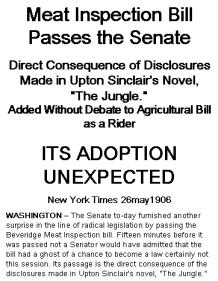Why All This Paperwork?? 2 They Called it “Smoked Sausage”
 Last time I talked about the days before there were any laws regulating foods and drugs; a time when “Let the Buyer Beware” was the law of the land. But as science advanced and America industrialized, that law was no longer sufficient.
Last time I talked about the days before there were any laws regulating foods and drugs; a time when “Let the Buyer Beware” was the law of the land. But as science advanced and America industrialized, that law was no longer sufficient.
Industrialization provided employment for enormous numbers of workers who flooded into the cities by the millions. As businesses learned how to use economies of scale, costs dropped dramatically.
The meat packing companies had to drive costs as low as possible if they were to stay in business. Competition was fierce because now they were not competing with just the butcher shop on the other side of town. They were part of a continental economy. Meat packers all over the country were fighting like gladiators to survive in a market that was linked by the rail system.
Butchers were skilled and costly workers, similar to the machinists who built cars at the time. There simply weren't enough of them to produce the volumes of meat that the growing urban workforce needed. So the meat packing industry re-invented itself by turning its business process on its head.
Rather than employing expensive butchers to slaughter and cut up each whole animal, then move on to the next one, they put the carcass on a hook attached to a conveyer belt. The belt moved the carcasses to the workers who each performed a single, simple task over and over again. The meat packers had invented a moving dis-assembly line.
These workers were much less skilled than a butcher. They were paid much less, and often could speak little English. If they didn't produce, they were fired and were replaced immediately. This was possible because the industry had brilliantly structured the slaughter houses so that every job could be learned in minutes.
Prices to consumers dropped to a fraction of what they had been before. Urban workers now had access to protein that simply wasn't available before. But there were also unanticipated consequences.
The unyielding pressure on cost caused the meat packers to cut corners where-ever they could, both in cleanliness and the ingredients they used. Even the operators who wanted to sell high quality products were forced to follow the competition to the lowest common denominator.
The unsanitary practices that the slaughter houses used were reported in newspapers and in magazine articles. But they really didn't get widespread notice until Upton Sinclair used slaughter houses as the setting for his best selling novel, "The Jungle".
The mountainous quantities of meat processed through the slaughter houses attracted hordes of unwanted pests. As was detailed in "The Jungle", “These rats were nuisances, and the packers would put poisoned bread out for them; they would die, and then rats, bread, and meat would go into the hoppers together.” The product was then sold as "smoked" sausage.
In the newly industrialized America consumers were confronted with a reality that had never been experienced before. They were using products that had been produced by complex technologies in a remote location.
 The book caused a public outcry and congress was pressed to enact legislation. The result was the Pure Food and Drug Act of 1906. The law prohibited the manufacture and interstate shipment of "adulterated" and "misbranded" foods and drugs.
The book caused a public outcry and congress was pressed to enact legislation. The result was the Pure Food and Drug Act of 1906. The law prohibited the manufacture and interstate shipment of "adulterated" and "misbranded" foods and drugs.
But in order to make a company stop selling adulterated products the government had to prove that the company intended to willfully to contaminate them. False therapeutic claims for patent medicines had escaped control as well.
Next time, The Elixir of Death.

Add new comment